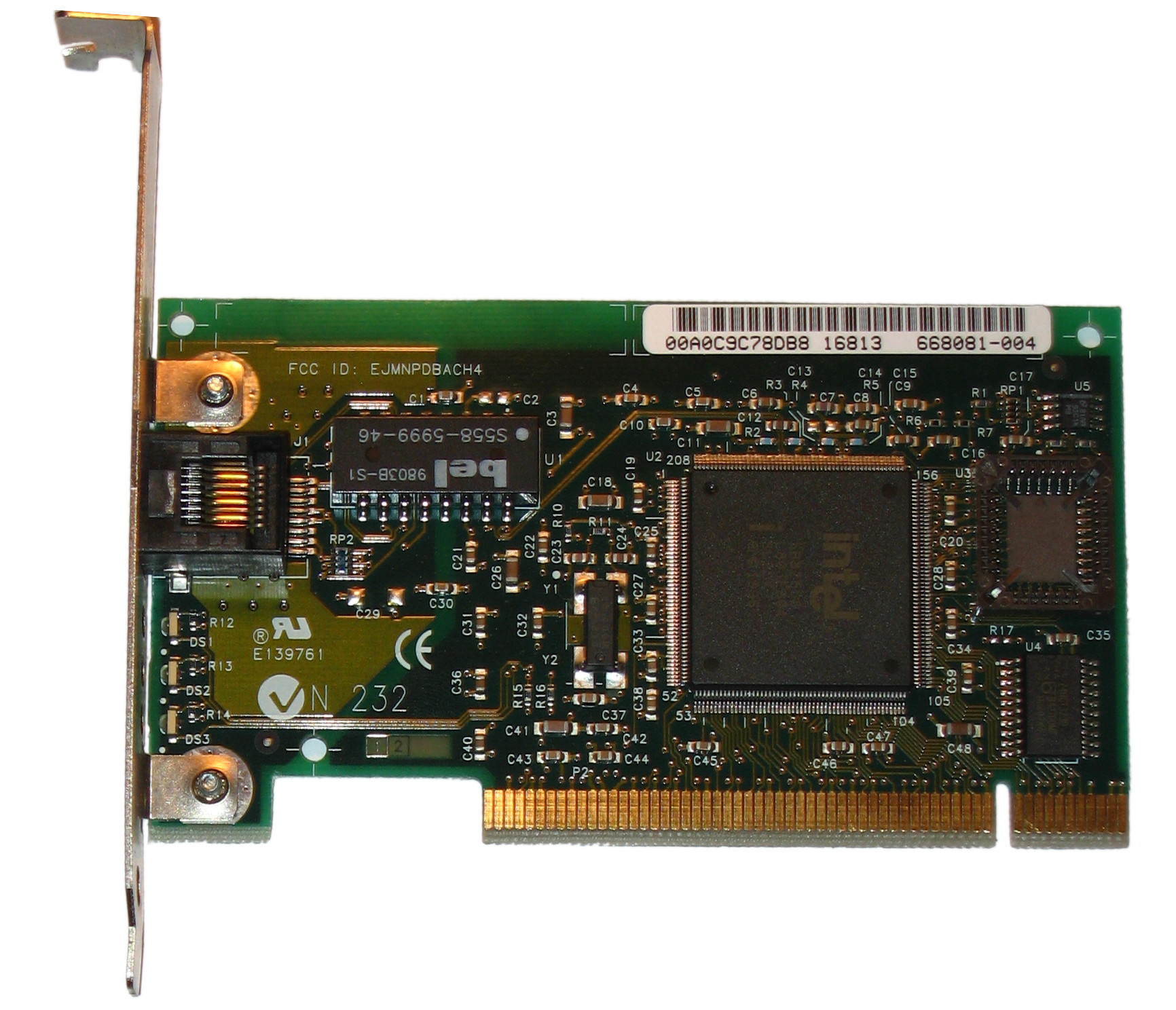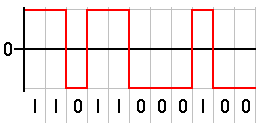|
100BaseVG
100BaseVG is a 100 Mbit/s Ethernet standard specified to run over four pairs of Category 3 cable (cable also known as voice grade, hence the "VG"). It is also called 100VG-AnyLAN because it was defined to carry both Ethernet and Token Ring frame types. 100BaseVG was originally proposed by Hewlett-Packard, ratified by the IEEE in 1995 and was practically extinct by 1998. In 2001 IEEE recorded the status of its 100BaseVG standard as being a "Withdrawn Standard" (defined as "A standard which is no longer maintained and which may contain significant obsolete or erroneous information.") Standardization 100BaseVG started in the IEEE 802.3 committee as Fast Ethernet. One faction wanted to keep carrier-sense multiple access with collision detection (CSMA/CD) in order to keep it pure Ethernet, even though the collision domain problem limited the distances to one tenth that of 10BASE-T. Another faction wanted to change to a polling architecture from the hub (they called it " Deman ... [...More Info...] [...Related Items...] OR: [Wikipedia] [Google] [Baidu] |
Fast Ethernet
In computer networking, Fast Ethernet Ethernet physical layer, physical layers carry traffic at the nominal rate of . The Classic Ethernet, prior Ethernet speed was . Of the Fast Ethernet physical layers, 100BASE-TX is by far the most common. Fast Ethernet was introduced in 1995 as the IEEE 802.3u standard and remained the fastest version of Ethernet for three years before the introduction of Gigabit Ethernet. The acronym ''GE/FE'' is sometimes used for devices supporting both standards. Nomenclature The ''100'' in the media type designation refers to the transmission speed of , while the ''BASE'' refers to baseband signaling. The letter following the dash (''T'' or ''F'') refers to the physical medium that carries the signal (twisted pair or fiber, respectively), while the last character (''X'', ''4'', etc.) refers to the line code method used. Fast Ethernet is sometimes referred to as 100BASE-X, where ''X'' is a placeholder for the FX and TX variants. General design Fast ... [...More Info...] [...Related Items...] OR: [Wikipedia] [Google] [Baidu] |
Category 3 Cable
Category 3 cable, commonly known as or station wire, and less commonly known as VG or voice-grade (as, for example, in 100BaseVG), is an unshielded twisted pair (UTP) cable used in telephone wiring. It is part of a family of standards defined jointly by the Electronic Industries Alliance (EIA) and the Telecommunications Industry Association (TIA) and published in TIA/EIA-568-B. Although designed to reliably carry data up to , modern data networks run at much higher speeds, and or better cable is generally used for new installations. Cat 3 cables may have 2, 3, 4, or more pairs. Networking was widely used in computer networking in the early 1990s for 10BASE-T Ethernet and, to a much lesser extent, for 100BaseVG Ethernet, Token Ring and 100BASE-T4. The original Power over Ethernet 802.3af specification supports the use of cable, but the later 802.3at Type 2 high-power variation does not.IEEE 802.3at-2009, clause 33.1.1c In some use cases and for short distances, Cat 3 may ... [...More Info...] [...Related Items...] OR: [Wikipedia] [Google] [Baidu] |
IEEE 802
IEEE 802 is a family of Institute of Electrical and Electronics Engineers (IEEE) standards for local area networks (LANs), personal area networks (PANs), and metropolitan area networks (MANs). The IEEE 802 LAN/MAN Standards Committee (LMSC) maintains these standards. The IEEE 802 family of standards has had twenty-four members, numbered 802.1 through 802.24, with a working group of the LMSC devoted to each. However, not all of these working groups are currently active. The IEEE 802 standards are restricted to computer networks carrying variable-size packets, unlike cell relay networks, for example, in which data is transmitted in short, uniformly sized units called cells. Isochronous signal networks, in which data is transmitted as a steady stream of octet (computing), octets, or groups of octets, at regular time intervals, are also outside the scope of the IEEE 802 standards. The number 802 has no significance: it was simply the next number in the sequence that the IEEE used fo ... [...More Info...] [...Related Items...] OR: [Wikipedia] [Google] [Baidu] |
Ethernet Over Twisted Pair
Ethernet over twisted-pair technologies use twisted-pair cables for the physical layer of an Ethernet computer network. They are a subset of all Ethernet physical layers. Early Ethernet used various grades of coaxial cable, but in 1984, StarLAN showed the potential of simple unshielded twisted pair. This led to the development of 10BASE-T and its successors 100BASE-TX, 1000BASE-T, 10GBASE-T and 40GBASE-T, supporting speeds of 10 and 100 megabit per second, then 1, 10 and 40 gigabit per second respectively. Two new variants of 10 megabit per second Ethernet over a ''single'' twisted pair, known as 10BASE-T1S and 10BASE-T1L, were standardized in IEEE Std 802.3cg-2019. 10BASE-T1S has its origins in the automotive industry and may be useful in other short-distance applications where substantial electrical noise is present. 10BASE-T1L is a long-distance Ethernet, supporting connections up to 1 km in length. Both of these standards are finding applications implementi ... [...More Info...] [...Related Items...] OR: [Wikipedia] [Google] [Baidu] |
Ethernet
Ethernet ( ) is a family of wired computer networking technologies commonly used in local area networks (LAN), metropolitan area networks (MAN) and wide area networks (WAN). It was commercially introduced in 1980 and first standardized in 1983 as IEEE 802.3. Ethernet has since been refined to support higher bit rates, a greater number of nodes, and longer link distances, but retains much backward compatibility. Over time, Ethernet has largely replaced competing wired LAN technologies such as Token Ring, FDDI and ARCNET. The original 10BASE5 Ethernet uses a thick coaxial cable as a shared medium. This was largely superseded by 10BASE2, which used a thinner and more flexible cable that was both less expensive and easier to use. More modern Ethernet variants use Ethernet over twisted pair, twisted pair and fiber optic links in conjunction with Network switch, switches. Over the course of its history, Ethernet data transfer rates have been increased from the original to the lates ... [...More Info...] [...Related Items...] OR: [Wikipedia] [Google] [Baidu] |
ARCNET
Attached Resource Computer NETwork (ARCNET or ARCnet) is a communications protocol for local area networks. ARCNET was the first widely available networking system for microcomputers and it became popular in the 1980s for office automation tasks. It was later applied to embedded systems where certain features of the protocol are especially useful. History Development ARCNET was developed by principal development engineer John Murphy, at Datapoint Corporation in 1976 under Victor Poor, and announced in 1977. It was originally developed to connect groups of their Datapoint 2200 terminals to talk to a shared 8" floppy disk system. It was the first loosely coupled LAN-based clustering system, making no assumptions about the ''type'' of computers that would be connected. This was in contrast to contemporary larger and more expensive computer systems such as DECnet or IBM's SNA, where a homogeneous group of similar or proprietary computers were connected as a cluster. The tok ... [...More Info...] [...Related Items...] OR: [Wikipedia] [Google] [Baidu] |
Symbol Rate
In a digitally modulated signal or a line code, symbol rate, modulation rate or baud is the number of symbol changes, waveform changes, or signaling events across the transmission medium per unit of time. The symbol rate is measured in '' baud'' (Bd) or ''symbols per second''. In the case of a line code, the symbol rate is the pulse rate in pulses per second. Each symbol can represent or convey one or several bits of data. The symbol rate is related to the '' gross bit rate'', expressed in '' bits per second''. Symbols A symbol may be described as either a pulse in digital baseband transmission or a tone in passband transmission using modems. A symbol is a waveform, a state or a significant condition of the communication channel that ''persists'', for a fixed period of time. A sending device places symbols on the channel at a fixed and known symbol rate, and the receiving device has the job of detecting the sequence of symbols in order to reconstruct the transmitted data. The ... [...More Info...] [...Related Items...] OR: [Wikipedia] [Google] [Baidu] |
Line Code
In telecommunications, a line code is a pattern of voltage, current, or photons used to represent digital data transmission (telecommunications), transmitted down a communication channel or written to a storage medium. This repertoire of signals is usually called a constrained code in data storage systems. Some signals are more prone to error than others as the physics of the communication channel or storage medium constrains the repertoire of signals that can be used reliably. Common line encodings are Unipolar encoding, unipolar, Polar encoding, polar, Bipolar encoding, bipolar, and Manchester code. Transmission and storage After line coding, the signal is put through a physical communication channel, either a transmission medium or data storage medium.Karl Paulsen"Coding for Magnetic Storage Mediums".2007. The most common physical channels are: * the line-coded signal can directly be put on a transmission line, in the form of variations of the voltage or current (often us ... [...More Info...] [...Related Items...] OR: [Wikipedia] [Google] [Baidu] |
Shielded Twisted Pair
Twisted pair cabling is a type of communications cable in which two conductors of a single circuit are twisted together for the purposes of improving electromagnetic compatibility. Compared to a single conductor or an untwisted balanced pair, a twisted pair reduces electromagnetic radiation from the pair and crosstalk between neighboring pairs and improves rejection of external electromagnetic interference. It was invented by Alexander Graham Bell. For additional noise immunity, twisted-pair cabling may be shielded. Cable with shielding is known as shielded twisted pair (STP) and without as unshielded twisted pair (UTP). Explanation A twisted pair can be used as a balanced line, which as part of a balanced circuit can greatly reduce the effect of noise currents induced on the line by coupling of electric or magnetic fields. The idea is that the currents induced in each of the two wires are very nearly equal. The twisting ensures that the two wires are on average the sam ... [...More Info...] [...Related Items...] OR: [Wikipedia] [Google] [Baidu] |
Optical Fiber
An optical fiber, or optical fibre, is a flexible glass or plastic fiber that can transmit light from one end to the other. Such fibers find wide usage in fiber-optic communications, where they permit transmission over longer distances and at higher Bandwidth (computing), bandwidths (data transfer rates) than electrical cables. Fibers are used instead of metal wires because signals travel along them with less Attenuation, loss and are immune to electromagnetic interference. Fibers are also used for illumination (lighting), illumination and imaging, and are often wrapped in bundles so they may be used to carry light into, or images out of confined spaces, as in the case of a fiberscope. Specially designed fibers are also used for a variety of other applications, such as fiber optic sensors and fiber lasers. Glass optical fibers are typically made by Drawing (manufacturing), drawing, while plastic fibers can be made either by drawing or by extrusion. Optical fibers typically incl ... [...More Info...] [...Related Items...] OR: [Wikipedia] [Google] [Baidu] |




